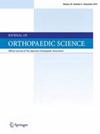单极桡骨头关节置换术治疗桡骨头粉碎性骨折时,松套式和压套式支架的放射影像学和临床比较。
IF 1.5
4区 医学
Q3 ORTHOPEDICS
引用次数: 0
摘要
目的:在桡骨头关节置换术(RHA)中,很少有临床研究对松动式和压入式植入柄的手术效果进行比较。我们旨在评估两种桡骨头植入物概念的放射学和临床效果:在这项回顾性多中心研究中,我们回顾了 2005 年至 2021 年间因桡骨头粉碎性骨折而接受 RHA 手术的 32 位患者(24 位女性和 8 位男性),他们的平均年龄为 63.1 岁。其中17名患者接受了松套式骨干(L组)RHA,其余15名患者接受了压套式骨干(P组)RHA。平均随访时间为(40.1 ± 9.9)个月,最短随访时间为 12 个月。对放射学结果进行了假体周围骨溶解评估;此外,还对临床结果进行了分析,以测量肘关节的活动范围。此外,还对再手术率和假体拆除率进行了审查:结果:两组患者的总体特征相似。L组的假体周围骨溶解率为17.6%,而P组为53.3%。L组和P组的平均肘关节屈曲度分别为128°和133°。L组和P组的肘关节平均伸展度分别为-12°和-9°。L组的再手术率为23.5%,P组为15.2%。L组中有一名患者因手术部位感染而被移除假体,而P组中有一名患者因疼痛松动而被移除假体:结论:在这项研究中,两种桡骨头假体概念在临床效果和再手术率方面没有明显差异。然而,P组的骨溶解发生率更高。尽管假体周围骨溶解的患者目前没有症状,但仍需对其症状进行长期仔细随访。本文章由计算机程序翻译,如有差异,请以英文原文为准。
Radiographic and clinical comparisons between loose-fit and press-fit stems in monopolar radial head arthroplasty for comminuted radial head fractures
Purpose
Few clinical studies have compared the operative outcomes between loose- and press-fit stems in radial head arthroplasty (RHA). We aimed to evaluate the radiographic and clinical results of the two radial head implant concepts.
Methods
In this retrospective multicenter study, 32 patients (24 women and 8 men) with a mean age of 63.1 years who underwent RHA for comminuted radial head fractures were reviewed between 2005 and 2021. Seventeen patients underwent RHA with a loose-fit stem (L-group), whereas the remaining fifteen patients underwent RHA with a press-fit stem (P-group). The mean follow-up period was 40.1 ± 9.9 months, with the minimum follow-up duration of 12 months. The radiographic findings were evaluated for periprosthetic osteolysis; furthermore, clinical outcomes were analyzed to measure the range of motion of the elbow. The rate of reoperations and prosthesis removal were also reviewed.
Results
The general characteristics of the patients were similar in the two groups. The rate of periprosthetic osteolysis was 17.6% in the L-group, whereas it was 53.3% in the P-group. The mean elbow flexions were 128° and 133° in the L- and P-groups, respectively. The mean elbow extensions were −12° and −9° in the L- and P-groups, respectively. The rate of reoperation was 23.5% in the L-group and 15.2% in the P-group. One patient in the L-group had the prosthesis removed because of surgical site infection, whereas one patient in the P-group had the prosthesis removed owing to painful loosening.
Conclusions
No significant differences in the clinical outcomes and reoperation rate were observed between the two radial head implant concepts in this study. However, osteolysis occurred more frequently in the P-group. Although patients with periprosthetic osteolysis are currently asymptomatic, they should be carefully followed up for the symptoms in the long term.
求助全文
通过发布文献求助,成功后即可免费获取论文全文。
去求助
来源期刊

Journal of Orthopaedic Science
医学-整形外科
CiteScore
3.00
自引率
0.00%
发文量
290
审稿时长
90 days
期刊介绍:
The Journal of Orthopaedic Science is the official peer-reviewed journal of the Japanese Orthopaedic Association. The journal publishes the latest researches and topical debates in all fields of clinical and experimental orthopaedics, including musculoskeletal medicine, sports medicine, locomotive syndrome, trauma, paediatrics, oncology and biomaterials, as well as basic researches.
 求助内容:
求助内容: 应助结果提醒方式:
应助结果提醒方式:


